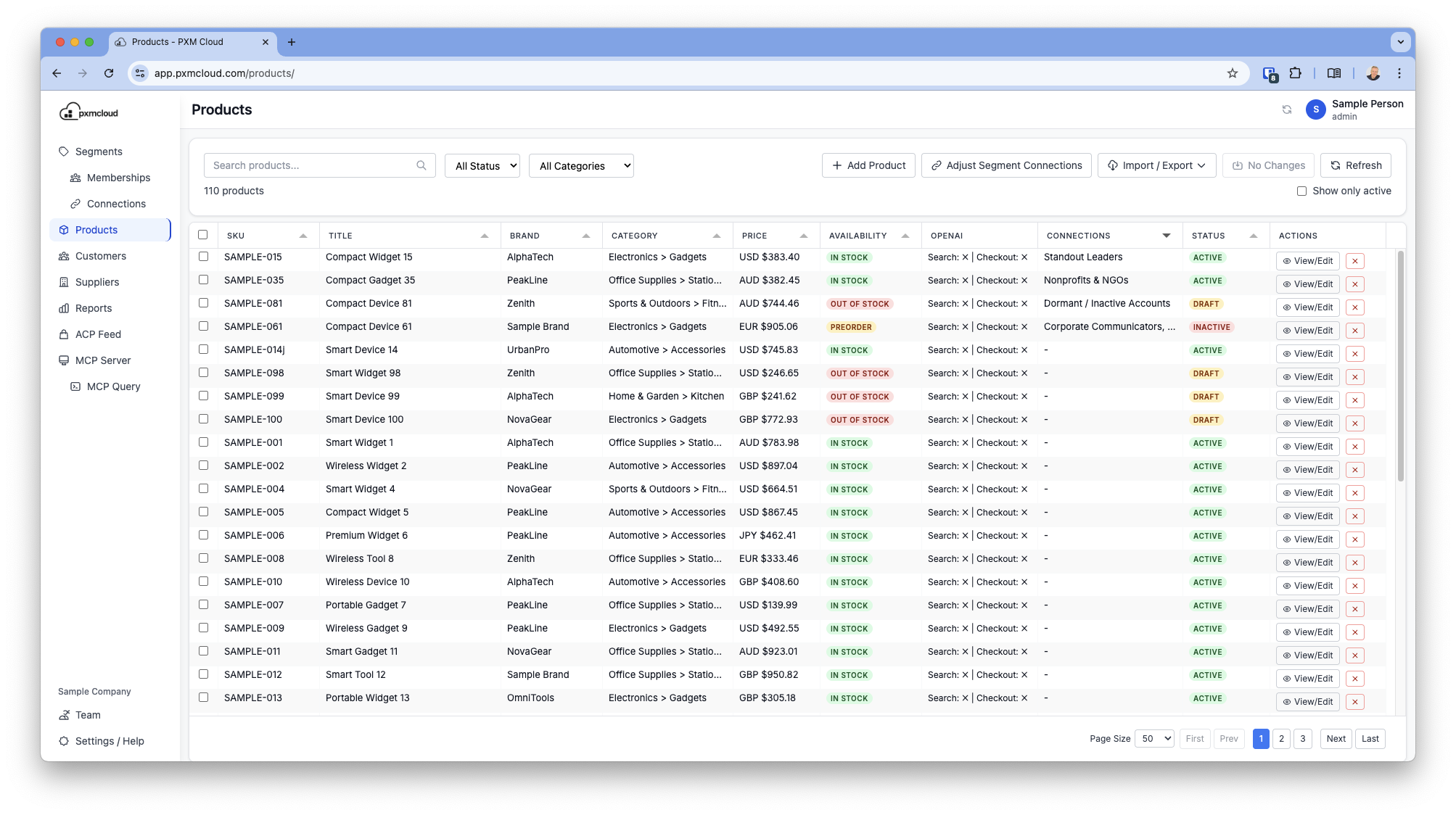What is Product Experience Management?
PXM
Product Experience Management (PXM) is a comprehensive system designed to create, manage, and optimize personalized product experiences across all customer touchpoints. A PXM system transforms product data into compelling, contextual experiences that resonate with different customer segments, channels, and markets.
Unlike static product catalogs or basic content management systems, PXM focuses on the customer experience layer—how product information is presented, personalized, and optimized for maximum engagement and conversion. It combines product data from PIM systems with customer intelligence from CRM systems to deliver experiences that feel personal and relevant to each individual customer.
PXM is essential for any organization focused on customer engagement, conversion optimization, and delivering differentiated product experiences that drive loyalty and revenue growth.
How PXM Systems Can Be Used
PXM systems serve multiple critical functions within modern customer experience operations:
Personalized Product Experiences
Create tailored product presentations based on customer behavior, preferences, and lifecycle stage. Deliver relevant product recommendations, customized descriptions, and targeted messaging that resonates with individual customers.
Multi-Channel Experience Optimization
Optimize product experiences across different channels (web, mobile, social, in-store) with channel-specific content, imagery, and messaging. Ensure consistent brand experience while adapting to channel-specific user behaviors.
Dynamic Content Management
Manage and deliver dynamic product content that changes based on customer segments, geographic location, time of day, or seasonal trends. Create compelling product stories that drive engagement and conversion.
Customer Journey Orchestration
Orchestrate seamless customer journeys across touchpoints, ensuring product experiences are relevant at each stage. Guide customers from discovery through consideration to purchase with contextual product information.
Performance Analytics & Optimization
Track and analyze customer engagement with product experiences, conversion rates, and satisfaction metrics. Use data-driven insights to continuously optimize product presentations and customer interactions.
Integration & Scalability
Integrate with PIM systems for product data and CRM systems for customer intelligence. Scale experiences across growing product catalogs and customer bases while maintaining personalization quality.
Industries Where PXM is Critical
PXM systems are essential across numerous industries, each with unique customer experience requirements and challenges:
E-commerce & Digital Retail
Why PXM matters: Creating personalized shopping experiences that drive conversion and customer loyalty across digital touchpoints.
Examples: Online fashion retailers personalizing product recommendations based on style preferences; Electronics retailers customizing product descriptions for different customer segments; Home goods companies adapting product presentations for mobile vs. desktop experiences.
B2B & Enterprise Sales
Why PXM matters: Delivering tailored product experiences for complex B2B buying processes with multiple stakeholders and long sales cycles.
Examples: Software companies customizing product demos for different industries; Industrial suppliers adapting product catalogs for different customer roles; Professional services firms personalizing service offerings based on client needs.
Subscription & SaaS
Why PXM matters: Optimizing product experiences to reduce churn and increase customer lifetime value through personalized onboarding and feature discovery.
Examples: SaaS platforms customizing feature presentations based on user behavior; Subscription services personalizing content recommendations; Software companies adapting product tours for different user personas.
Healthcare & Life Sciences
Why PXM matters: Creating compliant, personalized experiences for healthcare professionals and patients while maintaining regulatory standards.
Examples: Medical device companies customizing product information for different specialties; Pharmaceutical companies adapting messaging for different healthcare providers; Healthcare technology firms personalizing solutions for different practice types.
Financial Services
Why PXM matters: Building trust and engagement through personalized financial product experiences that address individual customer needs and risk profiles.
Examples: Banks customizing investment product presentations for different risk tolerances; Insurance companies adapting product descriptions for different demographics; Financial advisors personalizing portfolio recommendations based on client goals.
Manufacturing & Industrial
Why PXM matters: Delivering technical product experiences that help customers understand complex specifications and make informed purchasing decisions.
Examples: Industrial equipment manufacturers customizing technical documentation for different skill levels; Automotive suppliers adapting product information for different vehicle types; Chemical companies personalizing safety information for different applications.
PXM's Role in the Complete Ecosystem
PXM serves as the experience layer that transforms data from Product Information Management (PIM) systems and customer intelligence from Customer Relationship Management (CRM) systems into compelling, personalized customer experiences. While PIM ensures product data accuracy and CRM provides customer insights, PXM focuses on how that information is presented and experienced by customers.
Think of PXM as the customer experience orchestrator that takes accurate product data (from PIM) and customer understanding (from CRM) to create personalized, contextual experiences that drive engagement and conversion. PIM provides the product foundation, CRM provides the customer intelligence, and PXM creates the experience magic that makes products feel relevant and compelling to each individual customer.
Learn more about how PXM works with PIM and CRM systems in our comprehensive overview of the complete customer and product management ecosystem.
Key Benefits of Implementing PXM
Enhanced Customer Engagement
Create personalized product experiences that resonate with individual customers, driving higher engagement rates, longer session times, and increased brand loyalty.
Improved Conversion Rates
Optimize product presentations and customer journeys to increase conversion rates across all touchpoints. Deliver relevant experiences that guide customers through the sales funnel.
Omnichannel Consistency
Ensure consistent, personalized experiences across all customer touchpoints while adapting content and messaging to each channel's unique characteristics and user behaviors.
Data-Driven Optimization
Leverage customer behavior data and performance analytics to continuously optimize product experiences, content strategies, and customer journey orchestration.
Competitive Differentiation
Stand out from competitors by delivering unique, personalized product experiences that create emotional connections and drive customer preference for your brand.
Revenue Growth & Retention
Increase customer lifetime value through better product discovery, cross-selling opportunities, and reduced churn. Create experiences that keep customers engaged and coming back.
Tip: Start with a PXM implementation to create exceptional customer experiences. This works best when integrated with PIM systems for product data and CRM systems for customer intelligence.

